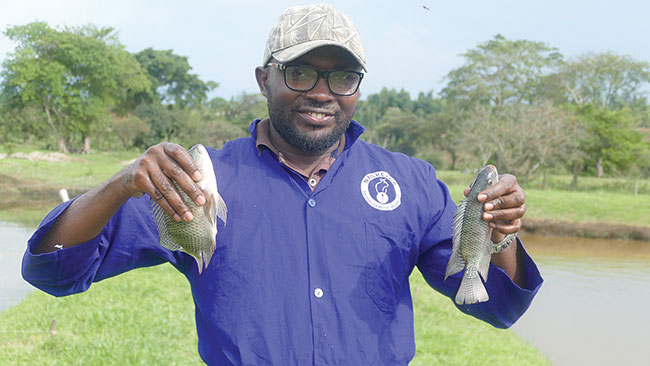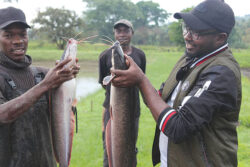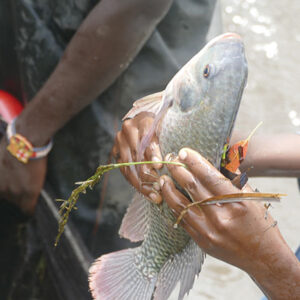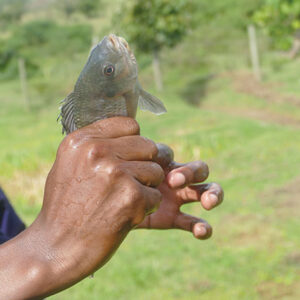
Features
Genetics
Breeding
Genetics Week
Research
Uganda steps up
The federal research agency aims to breathe new life to its aquaculture industry through genetic improvement.
June 7, 2023 By Bob Atwiine
 Ezra Byakora showing some of the genetically-improved tilapia
at Rubona farm.
Photos: Bob Atwiine
Ezra Byakora showing some of the genetically-improved tilapia
at Rubona farm.
Photos: Bob Atwiine In Uganda, aquaculture is a high-risk business that is prone to genetic factors. Yet, more than one million Ugandans are engaged in fish farming.
Many farmers in the country want to be in control of their own broodstock but this is not always possible and so they must import fry from other countries. Importing strains from other countries can sometimes bring biosecurity risks if not managed carefully and it is not always possible from a regulatory perspective.
The National Animal Genetic Resources Centre (NAGRC), a government research agency tasked with enhancing animal genetic improvement and productivity, has rolled out a program to revive fish breeding across all its stock farms.
Started at Kasolwe and Rubona stock farms, more fish production infrastructure has been established in other centre farms of Lusenke, Bulago and Maruzi. The aim is to enable production of quality fingerlings in all corners of the country and increase farmers’ access to them.
Priorities
NAGRC’s fish program is meant to support sustainable market-oriented fish production through fish genetic improvement for improved food security and household income.
Ezra Byakora, programme officer at NAGRC, says getting the right fish genetics has tremendous impact on achieving farming goals.
Byakora reveals that much of the priority is now focusing on improving the fish growth rates to six to seven months, such that fish farmers can have two production cycles every year.
“The foundation of all growth performance is the genetics and that is what we are trying to work on,” he explains. “We are looking at fish from different farms or different seed producers, and genetic issues of inbreeding, and also to do with fish strains of different species, comparing them with their farmed relatives.”
Byakora notes that the next focus, after growth performance, will be on disease resistance. The intensification of fish farming business in the country is increasing at higher and higher rates.
Optimized feed conversion ratios are also a research and development interest.
Government thinking
Byakora believes that with continued research and development in aquaculture, the government will be able to support youth, women farmers and other underprivileged groups of people by giving them fingerlings stock to be able to improve their livelihoods.
This will be supplemented by providing quality feed that is produced from an NAGRC farm in Kasolwe for ensured efficiencies in fish production at affordable prices.
The government has set a target of 1.7 million tonnes of fish production per year of which one million is expected to be from aquaculture.
Target species
According to Byakora, NAGRC will focus its research specifically on Nile tilapia, African catfish, and mirror carp fish. These are considered cheap, “poor man’s” fish but have now become everyone’s fish and one of the most viable ventures in aquaculture.
In fact, tilapia and catfish are the main reason Uganda’s fisheries sub-sector is the second highest agricultural foreign exchange earner.
According to Uganda’s Central Bank statistics, over the last 15 years, the fisheries and aquaculture sector has played an important social and economic role in Uganda, contributing 26 per cent of its Gross Domestic Product (GDP) and 123 per cent to agricultural GDP.
“Previously the improvement, most especially on tilapia, has been based on physical observation; by just looking at the size of the fish and doing selection. But now, we use genetics and genomics,” he says.
Unlike catfish, Byakora notes that tilapia’s survival rates are very high.
“Where we have a problem with catfish is because the system and the process of producing it is very sensitive, especially when it comes to incubation and hatchability,” he explains.
Catfish also usually experience problems with fungal infections. As a result, hatchling and fry survival rates are very low. Other problems also stem from the water quality and the feeding.
However, Byakora says they have set up good breeding infrastructure, currently using athen ponds that favour natural breeding behaviours and other indoor hatchery systems for catfish to guarantee high health status.
Education
Even with the demand for more development research, there are some industry players that remain skeptical of the value of investing in the genetic quality of their fingerlings and juveniles.

Ezra Byakora (right) and aquaculture technician, Aggrey Mukunde, pose with catfish reared at Rubona stock farm in Bunyangabu, Western Uganda.
“Previously, most farmers were not producing fish basing on the genetics. They just looked at the fish to see the size, colour or good shape, so they base on that for selection,” Byakora explained.
“We have had some training with farmers, including help from experts from the UK and we proved to them that you cannot do any improvements in fish without genetics and they really appreciated.”
Another source of skepticism among farmers and other industry players comes from a misconception that genetic improvement automatically means engineering of fish genes to produce Genetically Modified fish species, especially in Africa where GMOs are not popular.
“[Genetic improvement] is based on getting the best gene with evidence and crossing it with the medium or the worst to also improve them to something you want. This is not bringing a gene which is not in this fish and inserting it to another fish to produce GMOs,” Byakora emphasizes. “The farmers are now appreciating because of this explanation we give them.”
Print this page
- NOAA investigates aquaculture opportunities in Alaska
- NOAA announced record-breaking $3.3B for coastal resilience







